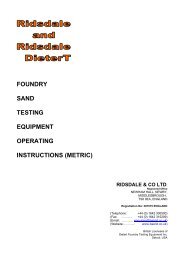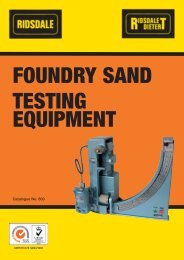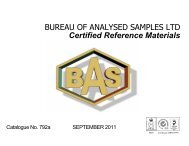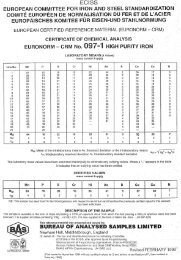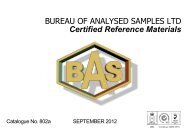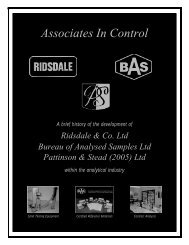AFS Foundry Sand Testing Equipment Operating Instructions Manual
AFS Foundry Sand Testing Equipment Operating Instructions Manual
AFS Foundry Sand Testing Equipment Operating Instructions Manual
- No tags were found...
Create successful ePaper yourself
Turn your PDF publications into a flip-book with our unique Google optimized e-Paper software.
RIDSDALE-DIETERT ELECTRIC PERMMETER (cont’d)IIIINSTALLATIONPlace the unit on a rigid level base, and connect to appropriate power supply (see nameplatefor correct voltage and frequency).IVTEST PROCEDURE(a)(b)Switch on blower motor by moving toggle switch to the “ON” position. Allow themotor to run for at least one minute in order to obtain a stable reading on the gauge.Select the orifice required for the sand sample to be tested. The general rule fordetermining the orifice required is :-(i)(ii)If the permeability number of the sample is over 50, use the large orificemarked ‘L’.If the permeability number of the sample is under 50, use the small orificemarked ‘S’.(c)(d)(e)Place the specimen tube with the sand sample uppermost over the centre post of thepermmeter.Rotate the knurled ring of the centre post anti-clockwise to seal the specimen tube.Place the lever on the left-hand side of the permmeter body in the “CHECK” (forward)position.(f) Adjust the motor speed control rheostat to obtain a pressure reading of exactly 100mm or ‘O’ permeability on the pressure gauge.(g)(h)(i)Move the lever to the “TEST” (rear) position, and read permeability from theappropriate scale according to the orifice in use.Return lever to its “CHECK” position and confirm that a pressure of 100 mm is stillrecorded.Release the specimen tube by rotating the knurled ring in a clockwise direction.VCALIBRATION AND MAINTENANCEThis instrument can only be calibrated by comparison with sands of known permeability.However, to check that the instrument is working correctly, and that the orifices have notbeen damaged (or blocked), it is supplied with two check jets.Each of these check jets is mounted in a rubber bung which can be placed in the end of aspecimen tube. The check jet marked 150 should be used for testing the large orifice andthe check jet marked 15 for testing the small orifice. The tube with the bung in one end isplaced on the instrument as in normal testing.When using the check jets the permeability number indicated on the dial of the instrumentshould correspond with the number stamped on the check jet, subject to a tolerance of ± onedivision (ie, ±10 for the 150 jet and ±1 for the 15 jet).70



